Ever since its introduction as a 1995 model, the Toyota Avalon has been pigeonholed as a Japanese Buick. For three generations the Camry-based flagship has been roomy, comfortable...and about as exciting to look at and drive as your grandmother's sofa. Road-going sofas used to sell well. But their fans now have at least one foot in the grave. In search of younger buyers, the Buick LaCrosse gained a sweeping roof line and a firmer suspension three years ago. Korea's best Buick, the Hyundai Azera, underwent a similar transformation last year. For 2013, it's the Avalon's turn. Has Toyota changed the big sedan enough? Perhaps they've even changed it too much?
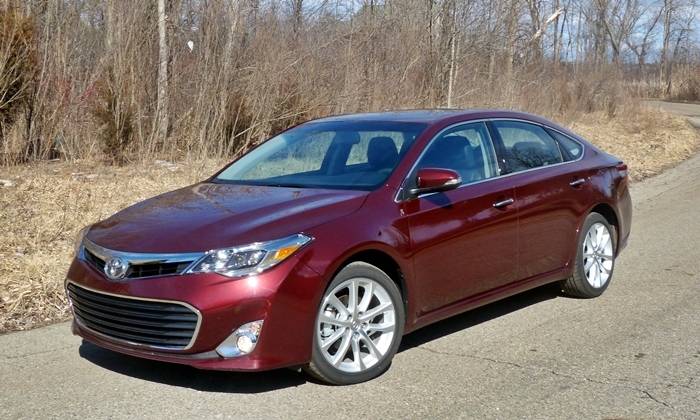
Not as swoopy as an Azera, but far sleeker than any past Avalon. more Avalon photos
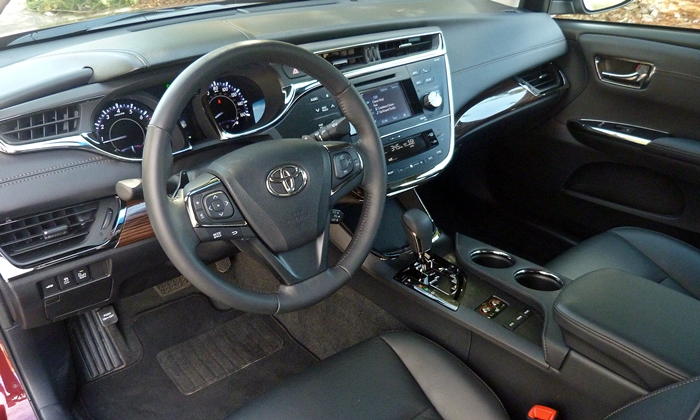
Plentiful chrome and French stitching. Ergonomically curved center stack.
| |
Compared to the Azera |
| Exterior styling |
 Better
Worse
Better
Worse
|
Nothing can change public perceptions of a car as quickly as dramatically new sheet metal. People who would never have considered a Toyota Avalon in the past have been asking me about the new one because of how it looks. The Avalon's exterior remains a little more conservative than those of the LaCrosse and Azera, but then maybe the Buick and Hyundai go a little too far with their more steeply raked windshields, fuller curves, and larger available wheels (19s vs. 18s). In comparison, the Avalon appears cleaner and leaner. Its upper body resembles that of an Audi A7, the most attractive four-door from a brand renowned for tasteful design.
Not that the Toyota's exterior is perfect. With at least one heavily-chromed grille too many and protruding headlights, the Avalon's face isn't nearly as tasteful as its Audiesque greenhouse. Also, the Avalon's rear overhang appears a little too long when viewed directly from the side. Audi would (and on the A7 does) position the rear wheels a little farther back.
Ultimately, picking the most attractive large front-wheel-drive near-luxury sedan comes down to personal taste. How curvy do you like them?
| Driving position & visibility |
 Better
Worse
Better
Worse
|
The sleek new exterior robs the interior of about an inch of shoulder room. Still, the Avalon's cabin remains about as roomy as the Azera's, based on official specs. But subjective perceptions can differ from the specs. Because of how the Avalon's instrument panel and console are designed, it feels roomier up front than the Azera. Of even greater significance, forward visibility is much better in the Toyota, thanks to an instrument panel that, while far from compact, isn't as tall or as deep as the Hyundai's. (The LaCrosse, with incredibly thick A-pillars and small windows, also scores poorly in this area.)
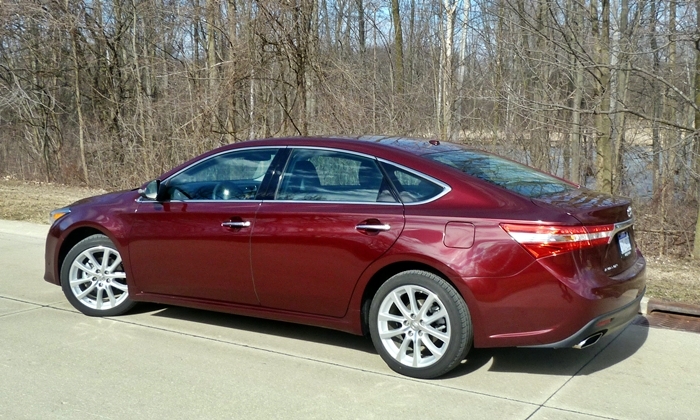
Fashionably sweeping roof line.
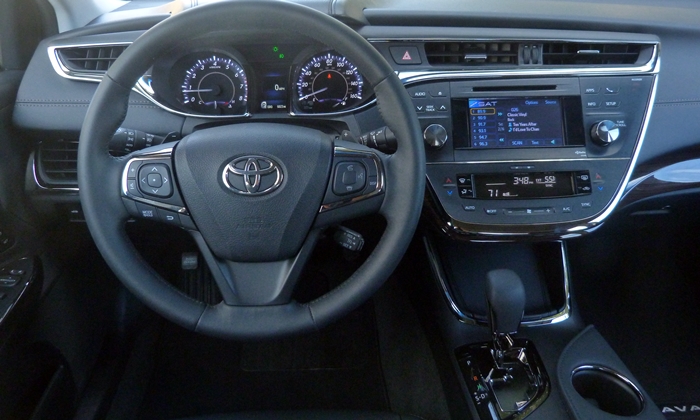
Some controls are even too easy to operate.
| Quietness |
 Better
Worse
Better
Worse
|
On an asphalt highway, very little noise penetrates the Avalon's interior. It's a very quiet car. On concrete there's more road noise, but this is generally the case. Patchy pavement, on the other hand, elicits an unexpected amount of tapping and thumping from the tires and suspension. Overall the Avalon is a little noisier than the LaCrosse, especially on rough roads, but is a little quieter than the Azera.
| Fuel economy |
 Better
Worse
Better
Worse
|
The Avalon's EPA ratings of 21 mpg city, 31 mpg highway are the best of any V6-powered large sedan. The Azera's numbers aren't too far behind (20/29). The LaCrosse's are (17/27). In our suburban driving we roughly matched the city figure. On the highway, though, we measured about 27. A number of factors might explain the shortfall. With a 70 mph limit, we were cruising well above the maximum speed of the EPA test cycle. Also, every seat was occupied and the trunk was chock full of luggage.
Desire better fuel economy? Well, for the first time the Avalon is also available with a hybrid powertrain, specifically the same 200-horsepower (combined) unit available in the Camry. With this engine, the EPA ratings are 40/39. But you'll give up the more effortless acceleration and sweeter sound of the 268-horsepower V6.
While the 3.5-liter V6 has changed very little since its introduction in the 2006 Avalon, and lacks the latest technology such as direct injection, it feels plenty strong and is among the best-sounding V6s. At low speeds and in turns traction is the limiting factor. All-wheel-drive would help, but unlike in the Buick isn't an option.
The transmission remains the same six-speed automatic Toyota has offered since 2007. It's smooth and responsive, especially in sport mode (offered with the XLE Touring and Limited). If you desire to call the shifts yourself anyway, this can be done via either paddles flanking the steering wheel or the lever. Econ mode makes top mpg easier to attain by dulling throttle responses and quickening upshifts.
| Handling |
 Better
Worse
Better
Worse
|
In a most unexpected turn of events, you'll find no float in the 2013 Avalon's ride. Even on badly paved roads body motions are now very well controlled. In hard turns the big Toyota no longer threatens to capsize, not even close, and there's just enough understeer to communicate that you're piloting a large, nosy-heavy, front-wheel-drive sedan.
Yet, as capable as it now is, the Avalon still doesn't encourage spirited driving. The steering, though less artificial than the quicker, heftier, oddly assisted system in the Azera, doesn't communicate enough of what's going on where the rubber meets the road. The Azera and LaCrosse aren't any more fun. But the Acura TL and Nissan Maxima are.
| |
Compared to the Azera |
| Ride smoothness |
 Better
Worse
Better
Worse
|
Unfortunately, the 2013 Avalon's much improved handling comes at the expense of ride quality. On unblemished roads the Toyota feels appropriately smooth, if not cushy. But the car firmly jiggles across even mildly patchy pavement, with attendant tire noise. The firm suspension has an especially hard time with some bumps and chuckholes, harshly crashing over them.
The LaCrosse and Azera have their own ride issues. Especially when fitted with its optional sport suspension, the Buick can pitch back-and-forth over regularly-spaced expansion joints. The Azera's ride can be the most unsettled, with especially sharp reactions to lane-spanning tar strips. One gets the sense that the Hyundai's suspension isn't up to the challenge of managing the mass of its optional 19-inch wheels.
While none of these cars has a truly awful ride, they're all significantly less insulating and cosseting than large sedan buyers have come to expect. For a more luxurious ride, check out the Chrysler 300.
| Front seat support & comfort |
 Better
Worse
Better
Worse
|
Compounding the Avalon's lack of suspension compliance, its seats are also firm, yet lacking in lateral support. You very much sit on them rather than in them. On a long drive my rear end reported impinged circulation. The front passenger is even worse off, as the tilt of that seat can be adjusted only in the Limited. Rear seat passengers also complained about overly firm, insufficiently contoured cushions.
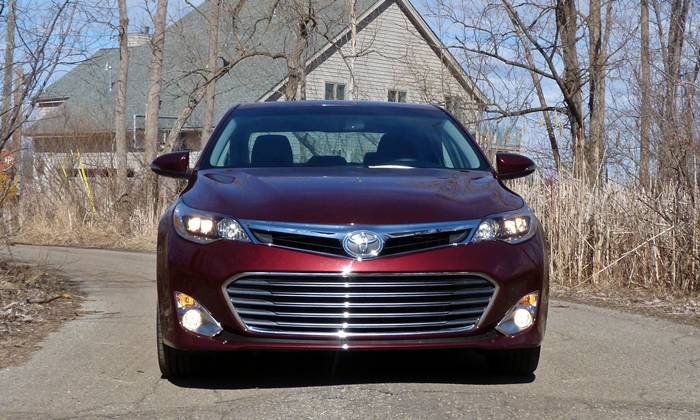
At least one heavily chromed grille too many?
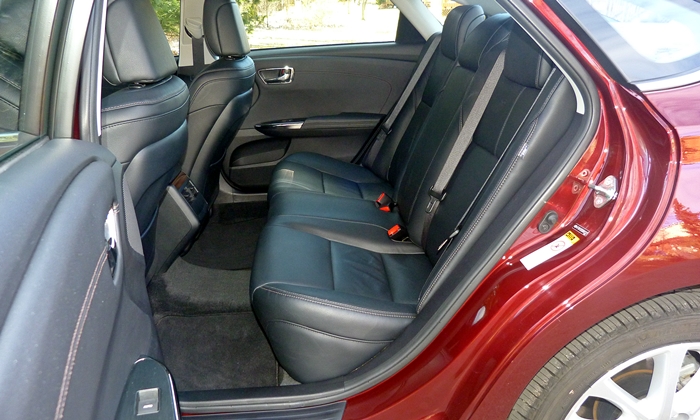
Roomy, but seat isn't comfortable.
| Controls and instruments |
 Better
Worse
Better
Worse
|
Toyota did a lot of things right with the 2013 Avalon's controls. Unlike many these days, the audio system has two large knobs. Other controls are touch sensitive, and react quickly and easily. The lower part of the center stack, where the climate controls are located, curves subtly upward to present the best angle for the driver's eyes and fingertips.
So what's the problem? Well, some of these controls are too responsive and too easy to operate. Many times we unintentionally set the thermostat well over 70 while fiddling with the nav or audio.
The Avalon's nav system warrants special mention. While Toyota deserves credit for making nav standard on the top two trim levels, and seemingly charging little for it, we found this system inordinately hard to use. It reacts slowly to touchscreen inputs and takes its sweet time when calculating a route. Start moving while the system is still calculating, and it sometimes aborts the process, forcing you to start over from the beginning. Once underway, lag can lead the system to significantly overstate the distance to an upcoming turn. Lastly, the screen is smaller than most in this price range, and, with little in the way of a hood, readily washes out. The same system is marginal in a $27,000 RAV4. In the $36,000+ Avalon, it's clearly subpar.
There are fewer good things about the Azera's controls, but also fewer repeated irritations.
| Materials & workmanship |
 Better
Worse
Better
Worse
|
At first glance, the new Avalon's interior is as boldly attractive as its exterior, with plentiful French stitching and thick chrome trim. It's much closer to a Lexus than a Camry. After a while, though, you notice that some of the materials don't measure up. The thick chrome trim is too obviously plated plastic rather than the real deal. While the face of the instrument panel is upholstered is an appropriately matte leatherette, the stitching that decorates the hood over the instruments has been inserted directly into a much shinier molded part. The effect is far from convincing, and it's directly in the driver's view. For a more consistently upscale appearance, Toyota should also upholster the top of the instrument panel. They might also tighten up or differently design the gap where the hood hops over the upholstered panel.
At first glance the Azera's interior doesn't appear as attractive or as upscale. But its interior materials are more consistent in quality and the leather on its seats feels richer.
| Price or payments |
 Better
Worse
Better
Worse
|
With a base price of $31,785, the 2013 Avalon starts over $2,000 below the 2012. About $700 of the drop is due to fewer standard features. The $36,295 Avalon XLE Touring undercuts a 2012 with heated seats, sunroof, and nav by $450 before adjusting for feature differences, and by over $1,800 afterwards.
However, while the Avalon is less expensive this year, it still costs considerably more than the Azera. The big question: do you want a sunroof or memory for the driver seat settings? The base Azera includes everything else on the tested Avalon XLE Touring. To get these two features, though, you must add the $4,000 Technology Package, which raises the Azera to parity with the top-of-the-line Avalon Limited. Without the Technology Package, the Azera lists for $3,170 less than the Avalon XLE Touring before adjusting for feature differences, and about $2,300 less afterwards. With the Technology Package, the Azera is $830 MORE before adjusting for feature differences, and about $1,800 less afterwards. Want premium audio, cooled front seats, xenon headlights, rear sunshades, and so forth (or merely power height and tilt adjustments for the front passenger)? Then you need to step up to the Avalon Limited, and the Azera with Technology Package is $3,320 less (with a virtually zero-dollar adjustment for feature differences).
The car most commonly cross-shopped with the Avalon on TrueDelta isn't the Azera, or the Buick LaCrosse. It's the Lexus ES. In the past the ES was most closely related to the smaller Camry. This time around, though, the ES shares much more, including a wheelbase 1.7 inches longer than the Camry's, with the Avalon. Some people will buy an Avalon because they consider it essentially the same as the Lexus, just for less money.
How much less money? Add heated seats, sunroof, and nav to the Lexus ES, and it costs $4,495 more than the Avalon XLE Touring. This is without also adding 18-inch wheels, which require a number of other options. What does $4,495 buy, aside from a higher-status brand? An additional year of warranty, a more attentive dealer, more conservative styling (aside from the brand's new "spindle" grille), a smoother ride, more comfortable seats, and a much better nav system.
The fourth-generation Toyota Avalon breaks with its predecessors with sleek styling and taut suspension tuning. The former change seems to be achieving the desired result. People who never would have considered an Avalon in the past are considering the new one. But the firm suspension together with firm seats could turn off buyers who put a higher priority on comfort than handling, while still not delivering the engaging experience sought by driving enthusiasts. To be fair, the Buick LaCrosse and Hyundai Azera have their own dynamic shortcomings. One or all might ride well enough on the roads you typically drive. Or not. To find out, arrange a test drive that includes these roads. As always, don't buy a car based on looks alone.

With 268 horsepower, Toyota 3.5-liter V6 down 25 compared to Azera 3.3, but torqier and plenty quick
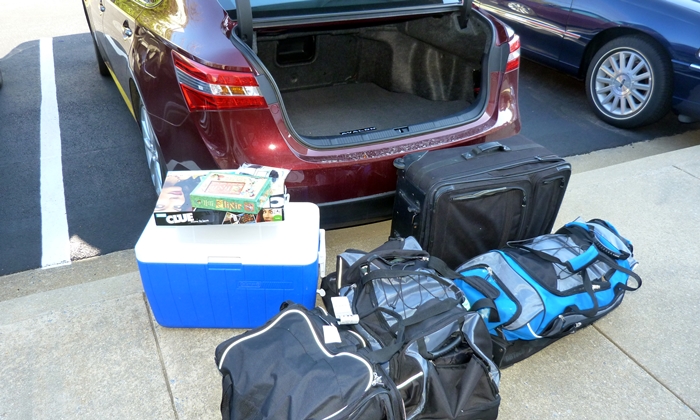
Large, if not the largest, trunk swallowed all of this, and more.
See more 2013 Toyota Avalon photos
Toyota provided an insured car for a week with a tank of gas.











